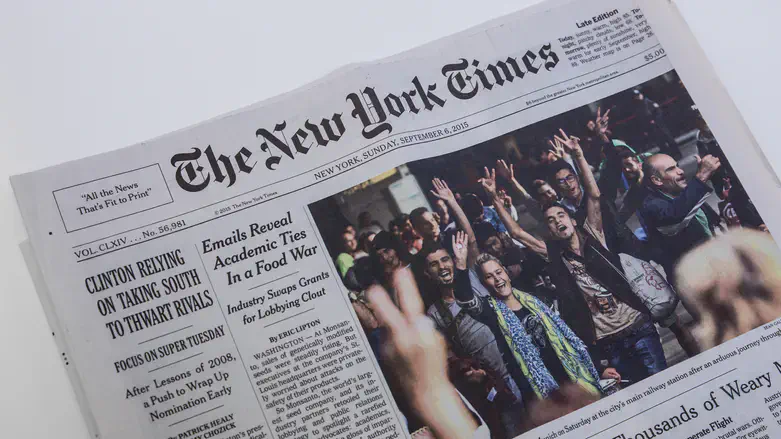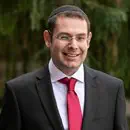
Gary Willig is a veteran member of the Arutz Sheva news staff.
Hundreds of Jewish people were doxed, hounded, threatened, and made to live in fear because of one unscrupulous New York Times reporter.
As reported by the Wall Street Journal, Natasha Frost downloaded 900 pages from a WhatsApp group set up by Jewish Australians in the aftermath of the Hamas attack on October 7, an attack that was deeply traumatic for Jews everywhere because it is the worst massacre committed against the Jewish people since the Holocaust. Frost then shared this information with the subject of one of her stories in January.
What happened next was as predictable as it was evil. Once the information was shared with one critic of Israel, it was fodder for antisemites everywhere. What began as a support group to help Jewish people deal with the horrors of October 7 became a source for new and recurring traumas.
In February, Clementine Ford, an antisemite who claims to be a feminist while brushing off the mass rapes and violence against women committed by Hamas, shared the information Frost so foolishly gave away on social media, and Jew-haters had new targets for their evil.
Death threats and other threats abounded. Businesses were vandalized. People moved just to escape the constant harassment. A family received a message with a picture of their 5-year-old son. The message read, “We know where you live.”
Frost has apologized for her actions, and the New York Times stated that it took disciplinary action against her, though what disciplinary action is unknown. But the problems did not originate with one simple error of judgment, but from a worldview that holds Jews up as objects of suspicion.
Frost’s original story in January centered on the decision by the Australian Broadcasting Corporation to let go of Antoinette Lattouf, a Lebanese-born reporter who had been hired for a five-day broadcasting gig and who was opposed by a group of Jewish lawyers over her comments denying that anti-Israel protesters chanted “gas the Jews” during an antisemitic demonstration outside the Sydney Opera House soon after October 7. She later celebrated when police claimed the chant was “where’s the Jews” as if that somehow proved the demonstrators where not antisemitic. Lattouf’s defense of an openly antisemitic and genocidal demonstration was not mentioned in Frost’s article, which depicted Lattouf as a victim of Jewish power and right-wing racism against minority journalists.
The story could have presented a more balanced and accurate picture of why Lattouf was controversial. It could have presented the context and the reasons the Jewish community of Australia has been concerned by the explosion of antisemitism that followed the Hamas massacre. It did none of those things, and the result was that antisemitism was whitewashed and ordinary Jews were demonized.
This is a pattern with the New York Times, which in 2016 published a glowing piece praising a pool in Toronto that had hours reserved for women-only swimming to accommodate the religious Muslim community, and that same year published an editorial criticizing a pool in Brooklyn that did the same thing to accommodate Hasidic Jewish women. It’s good when Muslims do it, and bad when Jews do it. The concerns of Jews are not to be taken anywhere near as seriously as the concerns of Muslims, even when those concerns are exactly the same.
This is the newspaper that buried stories about the Holocaust as the worst genocide in human history was ongoing, after all.
There is a blindness to antisemitism at left-wing institutions like the New York Times. This refusal to see antisemitism leads to the antisemitic tropes of Jewish power and Jewish perfidy whenever ordinary Jews so much as stick up for themselves, adding fuel to an already explosive atmosphere of hate.
When people openly calling for genocide are treated as anti-genocide or simple peace activists, when people who attack Jews at synagogues are treated as peaceful protesters, when attempts to hold accountable the most violent and rabidly hateful criminals are treated as assaults on free speech, when Nazi-level incitement to violence against Jews is treated as polite and acceptable discourse, this is the result. Jewish children threatened and communities living in fear.
If the pain Jews have felt since October 7 was taken seriously at the Times, if the fears Jews justifiably have were treated with the respect they deserve and not with derision, this would not have happened.
Will the New York Times learn its lesson? Almost certainly not. The only lesson the paper with a shameful record may learn is to be a little more careful about leaks in the future. But if the Times was going to learn to stop holding Jews, including the Jewish State, to double standards, if it was going to learn to start taking antisemitism seriously, it would have done so long ago.
When it comes to Jews, journalistic malpractice is the norm for the New York Times.
